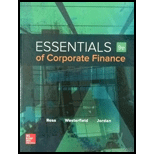
Essentials of Corporate Finance (Mcgraw-hill/Irwin Series in Finance, Insurance, and Real Estate)
9th Edition
ISBN: 9781259277214
Author: Stephen A. Ross Franco Modigliani Professor of Financial Economics Professor, Randolph W Westerfield Robert R. Dockson Deans Chair in Bus. Admin., Bradford D Jordan Professor
Publisher: McGraw-Hill Education
expand_more
expand_more
format_list_bulleted
Question
Chapter 15.8, Problem 15.8ACQ
Summary Introduction
To think critically about: The difference between the public and private bond issues.
Introduction:
When the company is need of money and they can raise money from the public. Issuing bonds is one of the methods to raise money from the public. The bond acts as a loan between the corporation and the investors.
Expert Solution & Answer
Want to see the full answer?
Check out a sample textbook solution
Students have asked these similar questions
10. Calculate the break-even point for a company with fixed costs $10,000, variable costs $5/unit, and selling price $10/unit.
no gpt ..???
7. If sales are $500,000 and gross profit margin is 30%, what is the cost of goods sold?
3. If a stock's beta is 1.5 and the market return is 12%, with a risk-free rate of 4%, what is the expected return?
Chapter 15 Solutions
Essentials of Corporate Finance (Mcgraw-hill/Irwin Series in Finance, Insurance, and Real Estate)
Ch. 15.1 - What is venture capital?Ch. 15.1 - Prob. 15.1BCQCh. 15.2 - Prob. 15.2ACQCh. 15.2 - Prob. 15.2BCQCh. 15.3 - Prob. 15.3ACQCh. 15.3 - Prob. 15.3BCQCh. 15.4 - Prob. 15.4ACQCh. 15.4 - Prob. 15.4BCQCh. 15.5 - Prob. 15.5ACQCh. 15.5 - Prob. 15.5BCQ
Ch. 15.6 - Prob. 15.6ACQCh. 15.6 - Prob. 15.6BCQCh. 15.7 - Prob. 15.7ACQCh. 15.7 - Prob. 15.7BCQCh. 15.8 - Prob. 15.8ACQCh. 15.8 - Prob. 15.8BCQCh. 15.9 - Prob. 15.9ACQCh. 15.9 - Prob. 15.9BCQCh. 15 - Prob. 15.1CCh. 15 - When is a new issue usually priced?Ch. 15 - What are the differences between general cash...Ch. 15 - Prob. 15.4CCh. 15 - Prob. 15.5CCh. 15 - What has been presented as a reason why stock...Ch. 15 - Prob. 15.7CCh. 15 - Prob. 15.8CCh. 15 - Prob. 15.9CCh. 15 - Debt versus Equity Offering Size. In the...Ch. 15 - Debt versus Equity Flotation Costs. Why are the...Ch. 15 - Prob. 3CTCRCh. 15 - Prob. 4CTCRCh. 15 - Prob. 5CTCRCh. 15 - Prob. 6CTCRCh. 15 - Prob. 7CTCRCh. 15 - Prob. 8CTCRCh. 15 - Prob. 9CTCRCh. 15 - Prob. 10CTCRCh. 15 - Prob. 1QPCh. 15 - Prob. 2QPCh. 15 - Prob. 3QPCh. 15 - Prob. 4QPCh. 15 - Prob. 5QPCh. 15 - Prob. 6QPCh. 15 - Prob. 7QPCh. 15 - Prob. 1CCCh. 15 - Prob. 2CCCh. 15 - Prob. 3CCCh. 15 - Prob. 4CC
Knowledge Booster
Learn more about
Need a deep-dive on the concept behind this application? Look no further. Learn more about this topic, finance and related others by exploring similar questions and additional content below.Similar questions
- 4. A company has $100,000 in assets and $50,000 in liabilities. What is its equity? Need a helpful..???arrow_forward4. A company has a debt-to-equity ratio of 1:2. If debt is $200,000, what is equity?arrow_forward9. If a company's current ratio is 2 and its current liabilities are $50,000, what are its current assets?no chatgpt???arrow_forward
- 5. Calculate the return on equity (ROE) for a company with net income $150,000 and equity $750,000.arrow_forward6. What is the price of a bond with face value $1,000, coupon rate 8%, and market interest rate 10%?arrow_forward9. A company has fixed costs $50,000, variable costs $10/unit, and sells products at $20/unit. What is the break-even point?arrow_forward
- 8. Calculate the weighted average cost of capital (WACC) for a company with 60% equity (cost 12%) and 40% debt (cost 8%). no gpt ..???arrow_forward8. Calculate the weighted average cost of capital (WACC) for a company with 60% equity (cost 12%) and 40% debt (cost 8%). Need a helpful..??arrow_forward3. If a company's net income is $100,000 and it has 10,000 shares outstanding, what is the earnings per share (EPS)? Correctly answer..???arrow_forward
- 10. If a stock's dividend yield is 5% and stock price is $100, what is the annual dividend payment? no gpt..???arrow_forward8. A stock has a beta of 1.2 and the market return is 10%. If the risk-free rate is 2%, what is the expected return? need a ai ..???arrow_forwardA corporation buys on terms of 2/8, net 45 days, it does not take discountes, and it actually pays after 62 days, what is the effective annual percentage cost of its non-free trade credit? Use a 365-day year) keep to the 6th decimal place for accuracyarrow_forward
arrow_back_ios
SEE MORE QUESTIONS
arrow_forward_ios
Recommended textbooks for you
 EBK CONTEMPORARY FINANCIAL MANAGEMENTFinanceISBN:9781337514835Author:MOYERPublisher:CENGAGE LEARNING - CONSIGNMENT
EBK CONTEMPORARY FINANCIAL MANAGEMENTFinanceISBN:9781337514835Author:MOYERPublisher:CENGAGE LEARNING - CONSIGNMENT Intermediate Financial Management (MindTap Course...FinanceISBN:9781337395083Author:Eugene F. Brigham, Phillip R. DavesPublisher:Cengage LearningPrinciples of Accounting Volume 1AccountingISBN:9781947172685Author:OpenStaxPublisher:OpenStax College
Intermediate Financial Management (MindTap Course...FinanceISBN:9781337395083Author:Eugene F. Brigham, Phillip R. DavesPublisher:Cengage LearningPrinciples of Accounting Volume 1AccountingISBN:9781947172685Author:OpenStaxPublisher:OpenStax College Cornerstones of Financial AccountingAccountingISBN:9781337690881Author:Jay Rich, Jeff JonesPublisher:Cengage Learning
Cornerstones of Financial AccountingAccountingISBN:9781337690881Author:Jay Rich, Jeff JonesPublisher:Cengage Learning Intermediate Accounting: Reporting And AnalysisAccountingISBN:9781337788281Author:James M. Wahlen, Jefferson P. Jones, Donald PagachPublisher:Cengage Learning
Intermediate Accounting: Reporting And AnalysisAccountingISBN:9781337788281Author:James M. Wahlen, Jefferson P. Jones, Donald PagachPublisher:Cengage Learning

EBK CONTEMPORARY FINANCIAL MANAGEMENT
Finance
ISBN:9781337514835
Author:MOYER
Publisher:CENGAGE LEARNING - CONSIGNMENT

Intermediate Financial Management (MindTap Course...
Finance
ISBN:9781337395083
Author:Eugene F. Brigham, Phillip R. Daves
Publisher:Cengage Learning

Principles of Accounting Volume 1
Accounting
ISBN:9781947172685
Author:OpenStax
Publisher:OpenStax College


Cornerstones of Financial Accounting
Accounting
ISBN:9781337690881
Author:Jay Rich, Jeff Jones
Publisher:Cengage Learning

Intermediate Accounting: Reporting And Analysis
Accounting
ISBN:9781337788281
Author:James M. Wahlen, Jefferson P. Jones, Donald Pagach
Publisher:Cengage Learning
Bonds Explained for Beginners | Bond Types 101; Author: TommyBryson;https://www.youtube.com/watch?v=yuKmHTgqZ5o;License: Standard Youtube License